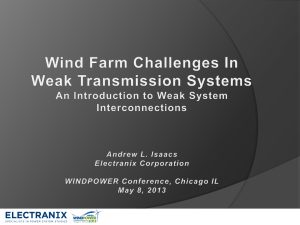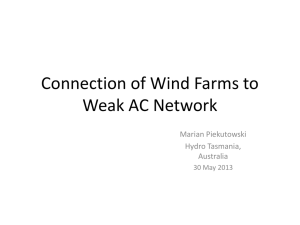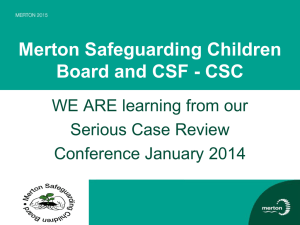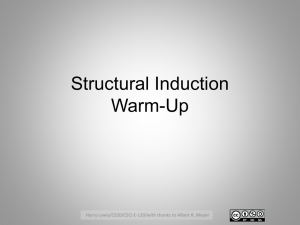File - Electrical Engineering
advertisement
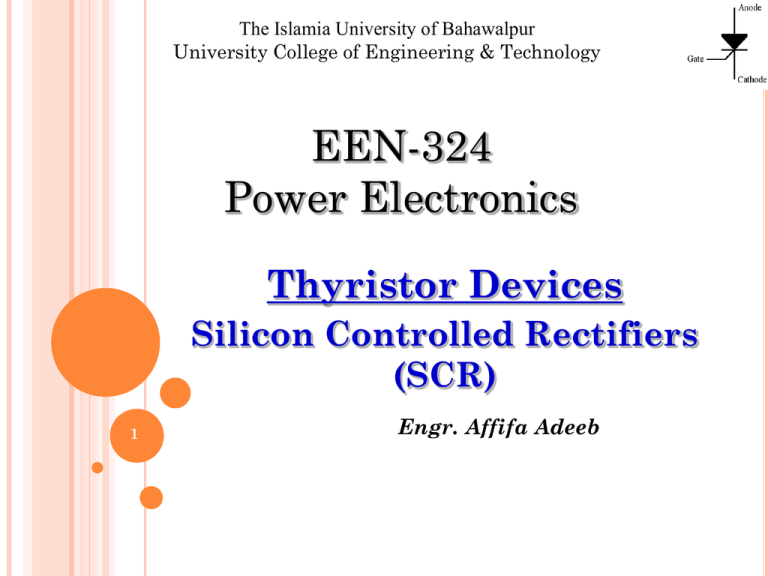
The Islamia University of Bahawalpur University College of Engineering & Technology EEN-324 Power Electronics Thyristor Devices Silicon Controlled Rectifiers (SCR) 1 Engr. Affifa Adeeb Power Semiconductor Switches Power Diodes 2 layer device Device Power Transistors 3 layer Device Thyristors 4 layer Thyristor devices can convert and control large amounts of power in AC or DC systems while using very low power for control. Thyristor family includes 1- Silicon controlled switch (SCR) 2- Gate-turnoff thyristor (GTO) 3- Triac 4- Diac 5- Silicon controlled switch (SCS) 6- Mos-controlled switch (MCT) 2 INTRODUCTION SCR is most popular of thyristor family due to its Fast switching action , small size and high voltage and current ratings. It is commonly used in power electronic applications. SCR has 3 terminals (gate provides control) SCR is turned on by applying +ve gate signal when anode is +ve with repect to cathode. SCR is turned off by interrupting anode current. PNPN structure Symbol 3 TWO TRANSISTOR MODEL OF SCR Gate requires small positive pulse for short duration to turn SCR on. Once the device is on, the gate signal serves no useful purpose and can be removed. 4 SCR CHARACTERISTIC CURVE 5 IDEAL CHARACTERISTIC OF SCR 6 SCR RATINGS (a) SCR Current Ratings 1- Maximum Repetitive RMS current Rating Average on-state current is the maximum average current value that can be carried by the SCR in its on state. RMS value of nonsinusoidal waveform is simplified by approximating it by rectangular waveform. This approximation give higher RMS value, but leaves slight safety factor. 7 Average value of pulse is Form factor is 8 Knowing the form factor for given waveform, RMS current can be obtained from I =fo(IAVE) RMS Maximum repetitive RMS current is given by I T(RMS) =fo(IT(AVE)) Conduction angle verses form factor Conduction angle (θ) Form factor (fo) 20° 5.0 40° 3.5 60° 2.7 80° 2.3 100° 2.0 120° 1.8 140° 1.6 160° 1.4 180° 1.3 9 CONDUCTION ANGLE Duration for which SCR is on. It is measured as shown 10 2- Surge Current Rating Peak anode current that SCR can handle for brief duration. 3- Latching current Minimum anode current that must flow through the SCR in order for it to stay on initially after gate signal is removed. 4- Holding Current Minimum value of anode current, required to maintain SCR in conducting state. 11 (B) SCR VOLTAGE RATINGS 1- Peak repetitive forward blocking voltage Maximum instantaneous voltage that SCR can block in forward direction. 2- Peak Repetitive Reverse Voltage Maximum instantaneous voltage that SCR can withstand, without breakdown, in reverse direction. 3- Non-repetitive peak reverse voltage Maximum transient reverse voltage that SCR can withstand. 12 (C) SCR RATE-OF-CHANGE RATINGS 1- (di/dt rating) Critical rate of rise of on-state current. It is the rate at which anode current increases and must be less than rate at which conduction area increases. To prevent damage to SCR by high di/dt value, small inductance is added in series with device. Vaue of required inductance is L>= Vp (di/dt)max 2- dv/dt rating Maximum rise time of a voltage pulse that can be applied to the SCR in the off state without causing it to fire. Unscheduled firing due to high value of dv/dt can be prevented by using RC snubber circuit. 13 (D) GATE PARAMETERS 1- Maximum Gate Peak Inverse Voltage Maximum value of negative DC voltage that can be applied without damaging the gatecathode junction. 2-Maximum Gate Trigger Current Maximum DC gate current allowed to turn on the device. 3- Maximum gate trigger voltage DC voltage necessary to produce maximum gate trigger current. 4- Maximum Gate Power Dissipation Maximum instantaneous product of gate current and gate voltage that can exist during forward-bias. 5- Minimum gate trigger voltage Minimum DC gate-to-cathode voltage required to trigger the SCR. 6-Minimum gate trigger current Minimum DC gate current necessary to turn SCR on. 14 Series and Parallel SCR Connections 15 SCRs are connected in series and parallel to extend voltage and current ratings. For high-voltage, high-current applications, seriesparallel combinations of SCRs are used. 16 SCRS IN SERIES Unequal distribution of voltage across two series SCRs. Two SCRs do not share the same supply voltage. Maximum voltage that SCRs can block is V1+V2, not 2VBO. 17 Resistance equalization Voltage equalization 18 RC equalization for SCRs connected in series. 19 SCRS IN PARALLEL Unequal current sharing between two SCRs is shown: Total rated current of parallel connection is I1+I2, not 2I2. 20 With unmatched SCRs, equal current sharing is achieved by adding low value resistor or inductor in series with each SCR, as shown below. Value of resistance R is obtained from: R=V1-V2 I2-I1 21 Current sharing in SCRs with parallel reactors Equalization using resistors is inefficient due to Extra power loss Noncompansation for unequal SCR turn-on and turn-off times. Damage due to overloading SCRs with center-tapped reactors is shown below. 22 SCR Gate-Triggering Circuits 23 Triggering circuits provide firing signal to turn on the SCR at precisely the correct time. Firing circuits must have following properties 1. Produce gate signal of suitable magnitude and sufficiently short rise time. 2. Produce gate signal of adequate duration. 3. Provide accurate firing control over the required range. 4. Ensure that triggering does not occur from false signals or noise 5. In AC applications, ensure that the gate signal is applied when the SCR is forward-biased 6. In three-phase circuits, provide gate pulses that are 120° apart with respect to the reference point 7. Ensure simultaneous triggering of SCRs connected in series or in parallel. 24 TYPES OF GATE FIRING SIGNALS 1. 2. 3. DC signals Pulse signals AC signals 25 (A) DC GATING SIGNAL FROM SEPARATE SOURCE 26 DC GATING SIGNALS FROM SAME SOURCE 27 DISADVANTAGE OF DC GATING SIGNALS 1. Constant DC gate signal causes gate power dissipation 2. DC gate signals are not used for firing SCRs in AC applications, because presence of positive gate signal during negative half cycle would increase the reverse anode current and possibly destroy the device. 28 (2) PULSE SIGNALS 1. 2. 3. Instead of continuous DC signal, single pulse or train of pulses is generated. It provides precise control of point at which SCR is fired. It provides electrical isolation between SCR and gate-trigger circuit. 29 SCR TRIGGER CIRCUITS USING UJT OSCILLATOR Circuit A 30 CIRCUIT B 31 SCR TRIGGER CIRCUIT USING DIAC 32 SCR TRIGGER CIRCUIT USING OPTOCOUPLER 33 (C) AC SIGNALS Resistive phase control RC phase control 34 TRIGGERING SCRS IN SERIES AND IN PARALLEL 35 SCR Turnoff (Commutation) Circuits 36 What is Commutation? The process of turning off an SCR is called commutation. It is achieved by 1. Reducing anode current below holding current 2. Make anode negative with respect to cathode Types of commutation are: 1. Natural or line commutation 2. Forced commutation 37 SCR TURNOFF METHODS 1. Diverting the anode current to an alternate path 2. Shorting the SCR from anode to cathode 3. Applying a reverse voltage (by making the cathode positive with respect to the anode) across the SCR 4. Forcing the anode current to zero for a brief period 5. Opening the external path from its anode supply voltage 6. Momentarily reducing supply voltage to zero 38 (1) CAPACITOR COMMUTATION SCR turnoff circuit using a transistor switch 39 SCR turnoff circuit using commutation capacitor Value of capacitance is determined by: C>= tOFF 0.693RL 40 (2) COMMUTATION BY EXTERNAL SOURCE 41 (3) COMMUTATION BY RESONANCE Series resonant turnoff circuit 42 Parallel resonant turnoff circuit 43 (4) AC LINE COMMUTATION 44 Other members of Thyristor Family 45 OTHER TYPES OF THYRISTORS 1. Silicon Controlled Switch (SCS) 2. Gate Turnoff Thyristor (GTO) 3. DIAC 4. TRIAC 5. MOS-Controlled Thyristor (MCT) 46 1. SCS Structure Symbol Equivalent circuit for SCS 47 (2) GTO Structure Symbol GTO Ideal VI characteristiccs 48 (3) DIAC Structure Symbol VI characteristics of diac 49 (4) TRIAC Structure Symbol SCR equivalent circuit 50 TRIAC VI CHARACTERISTICS 51 (5) MCT Symbol equivalent circuit MCT VI characteristics 52 ASSIGNMENT#1 1. 2. Does gate current has any effect on forwardbreakover voltage? Justify the statement “Higher the gate current, lower is the forward breakover voltage.” Discribe briefly following members of thyristor family. Programmable Unijunction Transistor (PUT) Silicon Unilateral Switch (SUS) Static Induction Thyristor (SITH) Light Activated Thyristor (LASCR) 53



